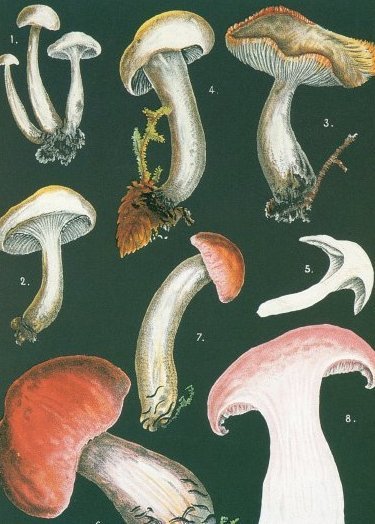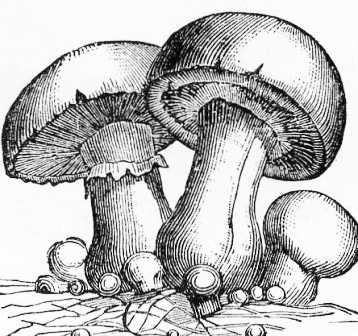Fungi Foraging
A First Outing by our Education Correspondent.
 This November I spent a day messing about in woods looking for edible fungi (mushrooms if you prefer). My original plan had been to send my husband, on his own, on a fungi identification course. He had wanted to do this for some time but, as with other slightly exotic wishes, had never got around to arranging it. This year, as I racked the brain for something to give him for our wedding anniversary, something which did not involve golf, fishing or gardening, I remembered his wish to go out into the countryside and gather mushrooms which he would then cook--all for free. Very important in these strained economic times.
This November I spent a day messing about in woods looking for edible fungi (mushrooms if you prefer). My original plan had been to send my husband, on his own, on a fungi identification course. He had wanted to do this for some time but, as with other slightly exotic wishes, had never got around to arranging it. This year, as I racked the brain for something to give him for our wedding anniversary, something which did not involve golf, fishing or gardening, I remembered his wish to go out into the countryside and gather mushrooms which he would then cook--all for free. Very important in these strained economic times.
However when it came to finding one of these courses I was not initially successful. First I Googled “identifying mushrooms” and came up with too many hits. On inspection few were exactly what I wanted. Some were group walks with no instructor, others were expensive weekends in hotels too far away; many of the other courses also involved long journeys. Finally I found a group in our area that holds fungi foraging walks with an expert who can identifiy the various species of mushrooms. The group convenes most weekends in places about an hour from our house in Oxfordshire. I joined the group and informed my husband of his present. Success!
He then had to decide on the day he wanted to go--not easy in the changeable weather of November when the prospect of tramping through dank woods does not appeal. He also wanted me to accompany him so that both of us could identify the fungi. We monitored the forecast over several days to ascertain whether the weekend weather would be reasonable. Finally one Friday it looked as if we were in luck. Sunday’s weather looked promising. An e-mail was sent informing the instructor that we would join the walk, which included lunch at a public house near the woods where we would forage for mushrooms.
The best laid plans.... Sunday dawned wet and windy, and we both wondered what we had let ourselves in for. Nevertheless, we set off for the Gloucestershire estate where the forage was scheduled. A number of people were already there and after introductions we set off. The idea was to spread out, find fungi and take them to Dave (our expert) for identification and collation. The results would then be sent to the county record office so that they knew what was growing and where. At this point it was still raining but the trees afforded some shelter.
Initially we were not successful because we did not know to move leaves and undergrowth around to search for the fungi. Then I almost stepped on a large specimen duly identified as a Coprinus Comatus (or to you and me the edible Shaggy Ink Cap or Lawyer’s Wig). Things improved. We prodded and poked, pulled up branches, peered down holes, turned over leaves. Although our original idea had been only to identify edible fungi, we became caught up in the group enthusiasm and searched out all sorts. During the course of a morning we found: Clitocybe geotropa, (trooping funnel; edible), Coprinus comatus (shaggy ink cap; edible), Crepidotus variabilis (variable oysterling; inedible), Mycena alcalina (stump bell cap; inedible), Mycena speirea (bark bonnet; inedible), Psathyrella conopilea (inedible), Rhodotus palmatus (inedible), Byssomerlulius coriu (inedible), Deadaleopsis confragosa (blushing bracket; inedible), Peniophora lycii (inedible), Lycoperdon pyriforme (stump puffball; edible when young but, when spores turn yellow, inedible), Tremella mesenterica (yellow brain fungus; inedible), Nectria cinnabarina (coral spot; inedible). Coprinus micaceus (ink caps - most are poisonous; only the shaggy ink cap is edible), Hypholoma fasciculare (sulphur tuft; poisonous. I managed one unseasonal find: the (inedible) Scarlet Elf-Cup (Sarcoscypha austriaca). In fact, and despite our original intent, most of what we found that morning was inedible.
We broke for lunch at the Fox in Great Barrington. Our choices of Steak and Kidney pudding and Roast Beef with Yorkshire pudding were good renditions of the classics and proof that nothing beats British food on a raw November day. Afterwards we decamped to another foraging area. We did not stay so long in the woods during the afternoon but still managed a few finds: Exidia thuretiana (white brain; inedible), Mycena galericulata (common bonnet; inedible), Clitocybe geotropa (edible but not tasty), Coprinus comatus (shaggy ink cap, edible)
On returning home we decided to cook our not inconsiderable ‘catch’ on toast - but unfortunately it did not taste as good as it looked. Indeed, in my (strictly limited) experience fungi foraging seems mainly to comprise a combination of fruitless searching and discovery of inedible and often toxic varieties with the occasional find of something that can be eaten but does not taste great. One variety, however, was notably tasty. The field blewits--highly prized by the experienced foragers in our group--had an intense mushroom flavor with nutty tones, but we thought that most of the edible mushrooms we collected were only suitable for stews. Ironically we had found Lepista saeva (the field blewit) in our own garden and taken it to the instructor for identification before we set off for the woods.
 A few days later our son brought us some oyster mushrooms he found on a rotting log in his garden. They were better than anything we had found and it took him no time to pluck them--no travelling and no subservience to a group. Maybe we could acquire our own rotting log.
A few days later our son brought us some oyster mushrooms he found on a rotting log in his garden. They were better than anything we had found and it took him no time to pluck them--no travelling and no subservience to a group. Maybe we could acquire our own rotting log.
Was the soggy hunt itself worthwhile? The answer would have to be yes and no. We enjoyed the day, the company and the education about fungi. There was also the slight frisson of excitement when we found something even if inedible, the free food, the knowledge that what we collected had no conservation issues, and the pleasant country walk. Nonetheless we did not find many edible mushrooms and those we did find were not that tasty, so our return to hunter-gatherer tradition was not as good as expected.
Will we go again? We probably will, but not until Spring when the weather is warmer and the sun reappears.
Recipes for morels on toast, potted mushrooms and Alexis Soyer's mushrooms under glass appear in the practical.
WARNING
It is vital to remember that some fungi are deadly poisonous. Two in particular (Amanita Phalloides or Death cap, and Amanita Virosa the Destroying Angel) are so dangerous that merely touching them causes illness; these two varieties also can be confused with edible mushrooms. If foraging appeals to you, make sure to get a good field guide (Patrick Harding, Tony Lyon and Gill Tomblin’s, How to Identify Edible Mushrooms (Collins, (1996), was recommended to us) and, ideally, join a group led by an expert. Above all, do not eat anything unless you know 100% for certain without a shadow of a doubt that it is totally and completely safe.
The Fox Inn is a seventeenth-century coaching house set in the village of Great Barrington near Burford, on the border of Gloucestershire and Oxfordshire. There are two choices of restaurants, one area in the main bar where Our group of foragers had a reservation in the main barroom; the Fox also has a riverside dining room and bar with a patio and beer garden overlooking the river Windrush. The atmosphere was lovely; lots of people eating and an open log fire on the day that we visited. The pub has a wide range of dishes, all of them homemade from local meat and produce. The menu is updated regularly with seasonal variations. There is a good selection of wines, as well as cask ales from the Donnington Brewery. They also offer bed and breakfast accommodation, and all rooms come with exclusive fishing rights on the Fox’s stretch of the river Windrush. Prices are reasonable; we paid just £34.00 for our lunches with a glass of merlot, a pint of beer and 2 cups of coffee.
For details visit the website www.foxinnbarrington.com.

